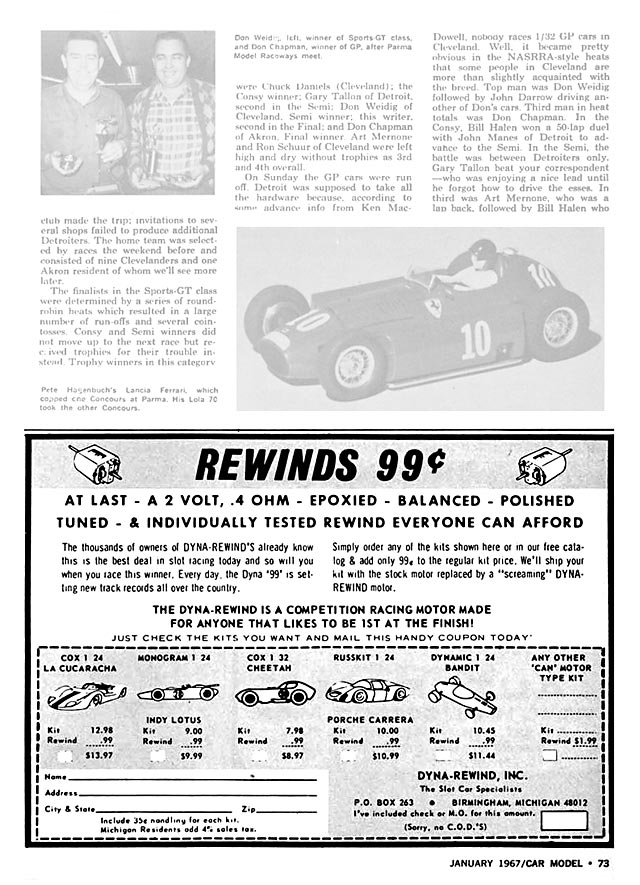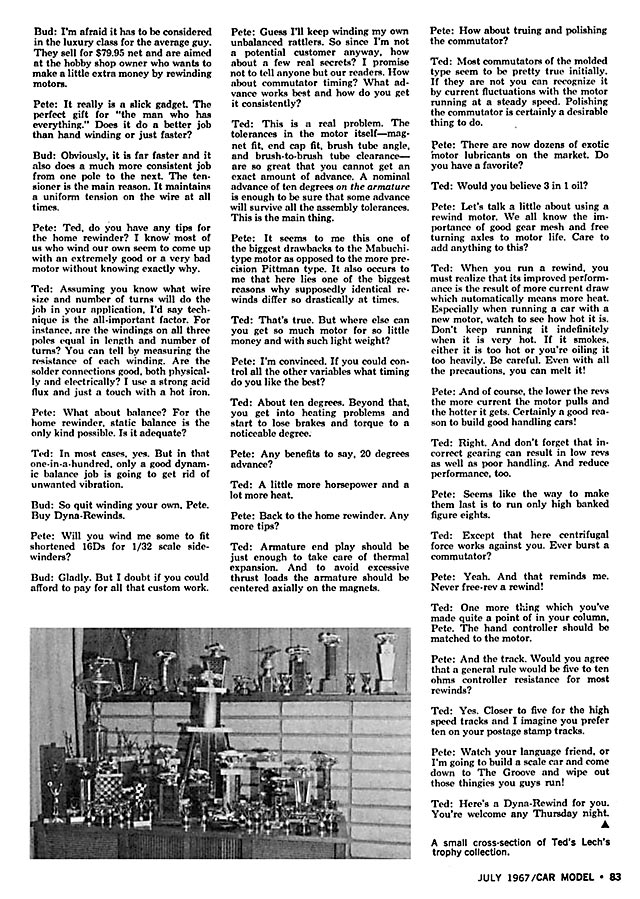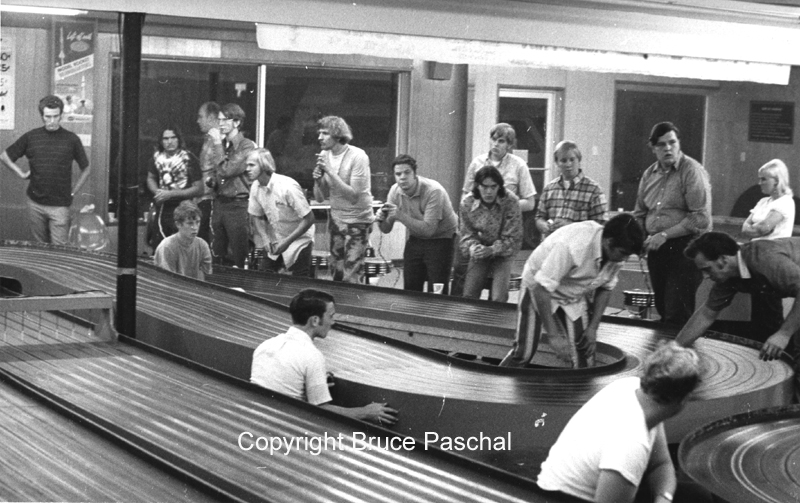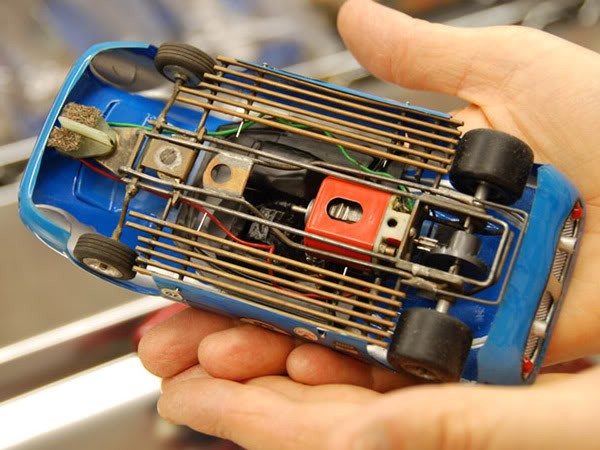Quote
Our Man in Detroit Talks With "Mr. Motor"When Ted Lech and Bud Stordahl — of Dyna-Rewinds fame — talk, we listen!by Pete HagenbuchASK ANY DETROIT hobby shop racer who's the man to beat and you'll get the same answer every time: Ted Lech. For the past several years, Ted has been blowing them off with convincing regularity all over the metropolitan Detroit area. He owns, or has owned, the track record at every shop worth mentioning. If you ask Ted what the secret is, he'll tell you horsepower plus handling with the accent on the horsepower. And if you ask his nearest competition, they'll tell you the same thing. Ted has recently gone into the rewound motor business and his Dyna-Rewinds are cleaning up. When Ted is beaten, which happens more frequently these days, it is usually with his own motors.I ran into Ted at The Groove in Royal Oak a while back and we discussed the possibility of bringing some of the secrets of Dyna-Rewinds to you. Ted was agreeable and a date was set. Bud Stordahl, Ted's partner and the business end of Dyna-Rewind, was brought along and the following conversation resulted.Pete: Bud, I've been seeing your ads in CAR MODEL and elsewhere, offering a Dyna-Rewind motor for 99 cents over the price of a car kit. Isn't this a good way to go broke before you even get going?Bud: No, we think this is a good way to introduce people to our line of motors. When you consider that we get the kits at wholesale, and keep the motor that comes in them, we even make a little on the offer. Not nearly enough to get rich but at least we don't lose our shirts.Ted: We have a good quality product which has to be tried to be appreciated. Our return sales on the kit offer are very encouraging.Pete: What, in your opinion, makes for a good quality commercial rewind?Ted: Well, first it is the quality of the parts that go into it. Everything we use is new. We use only high temperature wire; Nylclad, Formvar and Polythermaleze. Our winding is done on a production machine of our own manufacture. Number of turns and wire size are carefully chosen after testing under the conditions for which the motor is intended.Pete: What do you mean by these conditions?Ted: Power source — battery or power pack, length of straightway, type of car, etc.Pete: You mean you offer different motors for different applications?Ted: Yes. First we have our "mild" motor which we call the 2-volt. It has an armature resistance of .4-ohms and is usable with power pack or battery supply. This is the motor we recommend for the smaller tracks and lighter cars. Then we have our 1.3-volt model which has an armature resistance of .3-ohms. This one is available with either power pack or battery winding. And our top line motor is called the "Enduro." This one comes with the same winding as the 1.3-volt motors but with our Dyna 9 Indox magnets and the Polar Heat Cap. Also, on the Enduro motors, the wire connections are crimped on the commutator tabs to prevent throwing the wires in a burnout.Pete: We'll get back to the Polar Heat Cap later but first, when we speak of your various models, are they available to fit popular cans?Ted: The models I just mentioned are in the new ball bearing can size only. In order to streamline our production we are concentrating on this motor.Pete: I take it you're convinced the 26D is the best motor around?Ted: There is no comparison. It is the hottest tin can available right now.Pete: I'm sure it is, at least for 1/24 scale. But I'm still not convinced of its unbeatability in 1/32 scale. I'm afraid it's a little on the tall and heavy side for good handling in the little ones.Ted: What are you running in your Monster Merc?Pete: 26D sidewinder. But there are those who claim it isn't 1/32 scale. Sure, it handles like a dream but it is a great big car. The fat can seems to go pretty well in 1/32 stockers, too, but I have yet to see a normal size 1/32 car that handles well with one. How about Dyna offering a red hot 16D can for us little car lovers?Ted: Maybe later, if we find we can expand our product line.Pete: Now, what is the Polar Heat Cap?Ted: It is a ceramic coating applied to the commutator end of the armature winding. It does two things. It conducts heat away from the commutator for cooler operation and it provides a heat resistant shell which holds the connections in place when the motor suffers a burn-out. The connection can be easily resoldered and the motor is as good as new.Pete: Is the Polar Heat Cap any better than wrapping the connections with thread to hold the wires in place?Ted: Yes, because the heat cap also conducts heat away from the commutator.Pete: What other features do you build into your motors to make them reliable?Ted: We use a high temperature solder for the commutator connections. We impregnate the winding with high temperature epoxy resin.Pete: Anything else?Ted: Yes. We bake our armatures to insure a complete cure of the epoxy impregnation. We dynamically balance, and we recharge the magnets.Pete: There are a lot of old wive's tales going around about recharging magnets. Especially on tin can motors. Care to clear them up for us?Ted: To completely recharge barium-ferrite magnets, a heavy-duty charger. capable of producing 30.000 ampere turns, is necessary. Also, to do the best job, the magnets and can should be recharged as a unit with an iron core inserted between the magnets.Pete: What about all the chargers on the market which claim to be able to re-zap tin cans without disassembling them?Ted: There are heavy-duty chargers on the market which will greatly improve the performance of a motor with weak magnets. I know of no charger which will recharge the magnets to their original condition without removing the armature and substituting the iron core I mentioned earlier.Pete: How about some tune up tips for our readers?Ted: Sure. Lightly oil the motor bearings infrequently. Never use commutator lubricants. Increase brush tension.Pete: Care to be more specific on brush tension?Ted: We are speaking of rewinds, of course. On the small and large Mabuchis, re-bend the stock brush springs to a 120-degree included angle. On the new ball bearing can, use the stock brush springs from the large can.Pete: What about shimming magnets? I know it helps torque and brakes, but does it have any ill effects on the motor?Ted: There is a minimum air gap below which motor cooling is adversely affected. This is also true of using too many turns in a winding. The motor's ability to pump cooling air is reduced.Pete: Is there an ideal air gap?Ted: I like something close to .020 on a side. I would shim the magnets on the small and large cans and leave them alone on the 26D.Pete: Several outfits, yourselves included, are offering high strength magnets, either separately or included in rewound motors. What are your thoughts on these?Ted: It is another way to gain still higher performance. Of course, just sticking them into the motor may not do the job.Pete: You mean you have to change the winding to get the full effect.Ted: Yes. But also, at least on the small and large cans, you should remove some laminations from the armature to get the most out of the stronger magnetic field.Pete: Guess I'm smarter than I realized. I've been doing this for some time just to shorten the armatures for sidewinders. What's the science here?Ted: Very complicated. It has to do with the copper-to-iron ratio, and would take an article in itself just to touch the surface.Pete: Before we leave the subject of magnets, how important is the can itself in the magnetic field? What I'm getting at is that for a side-winder you pretty well butcher up the can in order to get rear axle clearance with the proper gearing. How much of an effect does this have on the field strength?Ted: A lot depends on the type of magnet. In the standard Mabuchi and Tradeship types, it will slightly decrease the field. But on the Indox magnets such as the Arcos and our Dyna 9s, it will seriously reduce field strength.Pete: What do you think of the slot-less commutators on the late model Mabuchis?Ted: They are more prone to burnouts than the slotted ones. Definitely not an improvement.Bud: As soon as the details are worked out, our Dyna-Rewinds will all he using our own slotted commutators with 11-degrees advance.Pete: I've been hearing a lot about your rewinding machine, but I've never seen one. Are they priced within reach of the average guy who likes to do his own rewinding?Bud: I'm afraid it has to be considered in the luxury class for the average guy. They sell for $79.95 net and are aimed at the hobby shop owner who wants to make a little extra money by rewinding motors.Pete: It really is a slick gadget. The perfect gift for "the man who has everything." Does it do a better job than hand winding or just faster?Bud: Obviously, it is far faster and it also does a much more consistent job from one pole to the next. The tensioner is the main reason. It maintains a uniform tension on the wire at all times.Pete: Ted, do you have any tips for the home rewinder? I know most of us who wind our own seem to come up with an extremely good or a very bad motor without knowing exactly why.Ted: Assuming you know what wire size and number of turns will do the job in your application, I'd say technique is the all-important factor. For instance, are the windings on all three poles equal in length and number of turns? You can tell by measuring the resistance of each winding. Are the solder connections good, both physically and electrically? I use a strong acid flux and just a touch with a hot iron.Pete: What about balance? For the home rewinder, static balance is the only kind possible. Is it adequate?Ted: In most cases, yes. But in that one-in-a-hundred, only a good dynamic balance job is going to get rid of unwanted vibration.Bud: So quit winding your own. Pete. Buy Dyna-Rewinds.Pete: Will you wind me some to fit shortened 16Ds for 1/32 scale sidewinders?Bud: Gladly. But I doubt if you could afford to pay for all that custom work.Pete: Guess I'll keep winding my own unbalanced rattlers. So since I'm not a potential customer anyway, how about a few real secrets? I promise not to tell anyone but our readers. How about commutator timing? What advance works best and how do you get it consistently?Ted: This is a real problem. The tolerances in the motor itself —magnet fit, end cap fit, brush tube angle, and brush-to-brush tube clearance — are so great that you cannot get an exact amount of advance. A nominal advance of ten degrees on the armature is enough to be sure that some advance will survive all the assembly tolerances. This is the main thing.Pete: It seems to me this one of the biggest drawbacks to the Mabuchitype motor as opposed to the more precision Pittman type. It also occurs to me that here lies one of the biggest reasons why supposedly identical rewinds differ so drastically at times.Ted: That's true. But where else can you get so much motor for so little money and with such light weight?Pete: I'm convinced. If you could control all the other variables what timing do you like the best?Ted: About ten degrees. Beyond that, you get into heating problems and start to lose brakes and torque to a noticeable degree.Pete: Any benefits to say, 20 degrees advance?Ted: A little more horsepower and a lot more heat.Pete: Back to the home rewinder. Any more tips?Ted: Armature end play should be just enough to take care of thermal expansion. And to avoid excessive thrust loads the armature should be centered axially on the magnets.Pete: How about truing and polishing the commutator?Ted: Most commutators of the molded type seem to be pretty true initially. If they are not, you can recognize it by current fluctuations with the motor running at a steady speed. Polishing the commutator is certainly a desirable thing to do.Pete: There are now dozens of exotic motor lubricants on the market. Do you have a favorite?Ted: Would you believe 3 in 1 oil?Pete: Let's talk a little about using a rewind motor. We all know the importance of good gear mesh and free turning axles to motor life. Care to add anything to this?Ted: When you run a rewind, you must realize that its improved performance is the result of more current draw which automatically means more heat. Especially when running a car with a new motor, watch to see how hot it is. Don't keep running it indefinitely when it is very hot. If it smokes, either it is too hot or you're oiling it too heavily. Be careful. Even with all the precautions, you can melt it!Pete: And of course, the lower the revs the more current the motor pulls and the hotter it gets. Certainly a good reason to build good handling cars!Ted: Right. And don't forget that incorrect gearing can result in low revs as well as poor handling. And reduce performance, too.Pete: Seems like the way to make them last is to run only high banked figure eights.Ted: Except that here centrifugal force works against you. Ever burst a commutator?Pete: Yeah. And that reminds me. Never free-rev a rewind!Ted: One more thing which you've made quite a point of in your column, Pete. The hand controller should be matched to the motor.Pete: And the track. Would you agree that a general rule would be five to ten ohms controller resistance for most rewinds?Ted: Yes. Closer to five for the high speed tracks and I imagine you prefer ten on your postage stamp tracks.Pete: Watch your language friend, or I'm going to build a scale car and come down to The Groove and wipe out those thingies you guys run!Ted: Here's a Dyna-Rewind for you. You're welcome any Thursday night.































